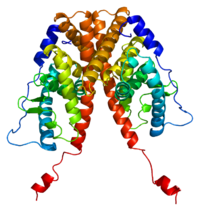
Photo from wikipedia
Abstract G protein-coupled estrogen receptor (GPER), a seven-transmembrane G protein-coupled receptor, mediates the rapid pre-genomic signaling actions of estrogen and derivatives thereof. The expression of GPER is extensive in mammal… Click to show full abstract
Abstract G protein-coupled estrogen receptor (GPER), a seven-transmembrane G protein-coupled receptor, mediates the rapid pre-genomic signaling actions of estrogen and derivatives thereof. The expression of GPER is extensive in mammal male reproductive system. However, the functional role of GPER in mouse sperm has not yet been well recognized. This study revealed that GPER was expressed at the acrosome and the mid-flagellum of the mouse sperm. The endogenous GPER ligand 17β-estradiol and the selective GPER agonist G1 increased intracellular Ca2+ concentration ([Ca2+]i) in mouse sperm, which could be abolished by G15, an antagonist of GPER. In addition, the G1-stimulated Ca2+ response was attenuated by interference with the phospholipase C (PLC) signaling pathways or by blocking the cation channel of sperm (CatSper). Chlortetracycline staining assay showed that the activation of GPER increased the incidence of acrosome-reacted sperm. Conclusively, GPER was located at the acrosome and mid-flagellum of the mouse sperm. Activation of GPER triggered the elevation of [Ca2+]i through PLC-dependent Ca2+ mobilization and CatSper-mediated Ca2+ influx, which promoted the acrosome reaction of mouse sperm. Graphical Abstract
Journal Title: Biology of Reproduction
Year Published: 2022
Link to full text (if available)
Share on Social Media: Sign Up to like & get
recommendations!